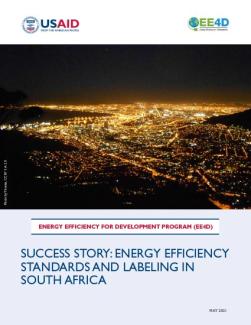Energy Efficiency Standards and Labeling in South Africa
Energy Efficiency for Development (EE4D)
Success Story – May 2021
This case study demonstrates the multi-benefits of implementing an energy efficiency standards and labeling program. It also illustrates how technical assistance can help countries address information gaps by supporting the development of key datasets that underpin energy efficiency policies and programs.
Energy efficiency policies support important goals in developing countries, such as reducing fuel imports, reducing energy cost burdens in low-income households, and reducing power sector capital requirements to meet increasing electricity demand. Adoption of energy efficiency technologies usually requires an up-front investment by consumers that pays off over time in the form of lowered energy bills.
Policymakers need to demonstrate both the cost-effectiveness of the investment and the relevance of the policy for national goals. For this reason, credible data about energy use, markets for technology, and related costs are indispensable components of technical analysis. Unfortunately, these data are often scarce in developing countries, posing a significant barrier to effective policy development.
Information Gaps in South Africa’s Energy Sector
Due to a combination of factors including aging power plants, slow development of new plants, and steadily rising energy consumption, South Africa experienced widespread rolling blackouts in 2008, which prompted the government to take drastic measures to implement energy saving initiatives. Chief among these was the implementation of an energy efficiency standards and labeling (EESL) program to reduce wasteful electricity consumption in the residential sector. In 2011, the Global Environment Facility (GEF), through the United Nations Development Programme (UNDP), awarded the Government of South Africa with a US$4.4 million grant to introduce and implement a mandatory EESL program.
However, implementation of the EESL program fell behind schedule due to the government’s lack of experience in implementing such a program and the lack of accessible, reliable data on potential energy savings. To remedy this, EE4D worked with UNDP to provide technical assistance to South Africa’s Department of Mineral Resources and Energy (DMRE) and the South Africa National Energy Development Institute (SANEDI) by sharing best practices and deploying tools to prioritize implementation activities.
Implementing an EESL program
Technical assessment tools can demonstrate the value of EESL programs by estimating the benefits to consumers and society as a whole. One such tool, EE4D’s Demand Resource Energy Analysis Model (DREAM), can provide an estimate of a program’s potential energy savings. In this case study, the EE4D team, DMRE, and SANEDI worked together over a five-month period to customize the DREAM tool so that it could be applied to the South African market. The tool has subsequently been used by DMRE as an input into the EESL regulation decision-making process, and for developing the country’s energy plans.
Another challenge that the EE4D team helped the South African government overcome was the lack of information about the efficiency levels of appliances sold in the market and the lack of experience in collecting this type of data. To counter this, Berkeley Lab developed the International Database of Efficient Appliances (IDEA) tool, which automatically gathers data from online retail sites and compiles it into a repository of information on the efficiency, price, and features of different appliances and devices in markets worldwide. Using data gleaned from IDEA, the EE4D team worked with local consultants to analyze market data and establish the efficiency baseline of South Africa’s appliance market. This led to the issuance of a new MEPS which entered into force in 2016. As the EESL program rolls out, EE4D continues to provide technical assistance to the government for developing additional standards.
Conclusions and Implications
Electricity savings from energy efficiency offer significant environmental and financial benefits. By 2030, the implementation of energy efficiency standards in South Africa will reduce CO2 emissions by 6.8 million tons (Mt), reducing emissions equivalent to the total CO2 emissions of Zambia. The country will also save about 10 billion liters of water per year by 2030, which would help alleviate stress on South Africa’s water supplies from recurring droughts. Air quality will also improve, as particulate emissions will be reduced by 3 kt, SOx emissions by 60 kt, and NOx emissions by 31 kt, which will alleviate the economic and health damages of poor air quality. Energy efficiency also proved to be a more cost-effective option to address South Africa’s energy needs. For example, based on the $4.4 million South Africa received from the GEF and the estimated $8.8 million of in-kind and cash cofinancing, it is estimated that the cost of implementing these EESL programs will be US 0.18 cents per kWh. This is much cheaper than the cost to supply an additional 1 kWh, which South Africa’s Integrated Resource Plan estimates to be US 7.9 cents per kWh.
This case study demonstrates the multi-benefits of energy efficiency and highlights how technical assistance can provide expert advice to develop specific policies and programs, as well as to address information gaps by supporting key datasets and modeling that underpin energy efficiency efforts. The study provided credible evidence of the benefits of the program which helped persuade stakeholders of the need for the market to implement minimum energy performance standards. It also helped build capacity at the government level by assisting with implementing and operating an impactful EESL program.

